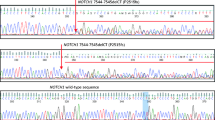Abstract
To analyze the relationship between miR-326 and Ets-1 mRNA levels in Treg cells and clinical manifestations in patients with SLE and explore the role of miR-326 and Ets-1 in the pathogenesis and activity of SLE. Twenty-five new-onset SLE patients without treatment, twenty-eight inactive SLE patients (SLEDA ≤ 4) and twenty-two healthy controls were included in the present study. Clinical data of SLE patients were recorded. Treg cells were purified by MACS from 20 ml peripheral blood, in which the quantity of miR-326 and Ets-1 mRNA were assessed by real-time PCR. Data were analyzed using SPSS Version 17.0. The nonparametric Mann-Whitney U test was used to compare the groups, The Spearman test was used for correlation analyses. Two-tailed p values <0.05 were considered statistically significant. 1.The level of miR-326 was significantly higher in Treg cells from SLE patients [1.98(0.592,6.148)] than that in healthy controls [0.921(0.345, 1.879)] (p = 0.032). The difference between new-onset SLE patients [6.192(0.673, 15.298)] and healthy controls was significant (p = 0.019). Significant difference of the miR-326 expression was found between new-onset SLE patients with serous cavity effusion and new-onset SLE patients without it(P<0.05). Significant positive correlation was found between the expression of miR-326 mRNA in Treg cells with CRP and anti-C1q antibody from new-onset SLE patients. 2. The level of Ets-1 mRNA was decreased in SLE patients [0.382(0.232, 0.572)] compared to healthy controls(p = 0.013). The difference was also found in new-onset SLE patients [0.222(0.125, 0.296)] while compared to healthy controls. Also, the level in new-onset SLE patients was lower than that in inactive SLE patients [0.482(0.398, 0.512)] (p = 0.001). 3. Negative correlation was found between miR-326 and Ets-1 mRNA expression in Treg cells from new-onset SLE patients (r = -0.583 p = 0.01). 4. There was no correlation of miR-326 or Ets-1 mRNA expression with SLEDAI. The increase of miR-326 expression in Treg cells from SLE patients may inhibit the expression of Ets-1 to participate in the pathological process of SLE.



Similar content being viewed by others
References
Xiao, C., L. Srinivasan, D.P. Calado, et al. 2008. Lymphoproliferative disease and autoimmunity in mice with increased miR-17-92 expression in lymphocytes. Nature Immunology 9: 405–414.
Du, C., C. Liu, J. Kang, et al. 2009. MicroRNA miR-326 regulates TH-17 differentiation and is associated with the pathogenesis of multiple sclerosis. Nature Immunology 10: 1252–1259.
Aschenbrenner, K., L.M. D'Cruz, E.H. Vollmann, et al. 2007. Selection of Foxp3+ regulatory T cells specific for self antigen expressed and presented by Aire + medullary thymic epithelial cells. Nature Immunology 8: 351–358.
Mouly, E., K. Chemin, H.V. Nguyen, et al. 2010. The Ets-1 transcription factor controls the development and function of natural regulatory T cells. Journal of Experimental Medicine 207: 2113–2125.
Han, J.W., H.F. Zheng, Y. Cui, et al. 2009. Genome-wide association study in a Chinese Han population identifies nine new susceptibility loci for systemic lupus erythematosus. Nature Genetics 41: 1234–1237.
Yang, W., N. Shen, D.Q. Ye, et al. 2010. Genome-wide association study in Asian populations identifies variants in ETS1 and WDFY4 associated with systemic lupus erythematosus. PLoS Genetics 6, e1000841.
He, C.F., Y.S. Liu, Y.L. Cheng, et al. 2010. TNIP1, SLC15A4, ETS1, RasGRP3 and IKZF1 are associated with clinical features of systemic lupus erythematosus in a Chinese Han population. Lupus 19: 1181–1186.
Xiang, N., X.P. Li, X.M. Li, et al. 2014. Expression of Ets-1 and FOXP3 mRNA in CD4(+)CD25 (+) T regulatory cells from patients with systemic lupus erythematosus. Clinical and Experimental Medicine 14: 375–381.
O'Connell, R.M., D. Kahn, W.S. Gibson, et al. 2010. MicroRNA-155 promotes autoimmune inflammation by enhancing inflammatory T cell development. Immunity 33: 607–619.
Jeker, L.T., and J.A. Bluestone. 2013. MicroRNA regulation of T-cell differentiation and function. Immunological Reviews 253: 65–81.
Yu, N., X. Li, W. Song, et al. 2012. CD4(+)CD25 (+)CD127 (low/-) T cells: a more specific Treg population in human peripheral blood. Inflammation 35: 1773–1780.
Wang, S., S. Lu, S. Geng, et al. 2013. Expression and clinical significance of microRNA-326 in human glioma miR-326 expression in glioma. Medical Oncology 30: 373.
Pan, Y, Li, XP, Sun, JF, et al. 2012. Effects of glucocorticoids on the expression of GTIR and apoptosis of the CD4 + CD25 + CD127dim / - T cells in patients with systemic lupus erythematosus. In. Journal of Peking University (Health sciences). 44:(42) 215–220.
Kefas, B., L. Comeau, D.H. Floyd, et al. 2009. The neuronal microRNA miR-326 acts in a feedback loop with notch and has therapeutic potential against brain tumors. Journal of Neuroscience 29: 15161–15168.
Gaitonde, S., D. Samols, and I. Kushner. 2008. C-reactive protein and systemic lupus erythematosus. Arthritis and Rheumatism 59: 1814–1820.
de Carvalho, J.F., B. Hanaoka, M. Szyper-Kravitz, et al. 2007. C-Reactive protein and its implications in systemic lupus erythematosus. Acta Reumatológica Portuguesa 32: 317–322.
Botto, M., and M.J. Walport. 2002. C1q, autoimmunity and apoptosis. Immunobiology 205: 395–406.
Li, Y., L.D. Sun, W.S. Lu, et al. 2010. Expression analysis of ETS1 gene in peripheral blood mononuclear cells with systemic lupus erythematosus by real-time reverse transcription PCR. Chinese Medical Journal 123: 2287–2288.
Ma, Q., X.P. Li, J.H. Tao, et al. 2013. Expression of Ets-1 and its related microRNAs in patients with systemic lupus erythematosus. China Journal of Rheumatology 17: 800–804.
Acknowledgments
This work was supported by grants from the National Natural Science Foundation of China (81373186). Special thanks to Ning Yu for her help in interpreting the significance of the results of this study.
Author information
Authors and Affiliations
Corresponding author
Ethics declarations
Conflict of Interest
No conflict of interest had been declared by the authors.
Rights and permissions
About this article
Cite this article
Sun, XG., Tao, JH., Xiang, N. et al. Negative Correlation Between miR-326 and Ets-1 in Regulatory T Cells from new-Onset SLE Patients. Inflammation 39, 822–829 (2016). https://doi.org/10.1007/s10753-016-0312-8
Published:
Issue Date:
DOI: https://doi.org/10.1007/s10753-016-0312-8




